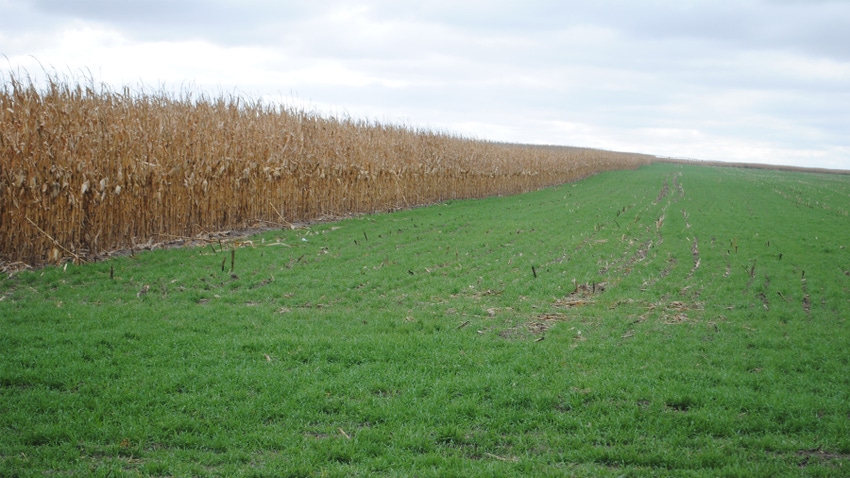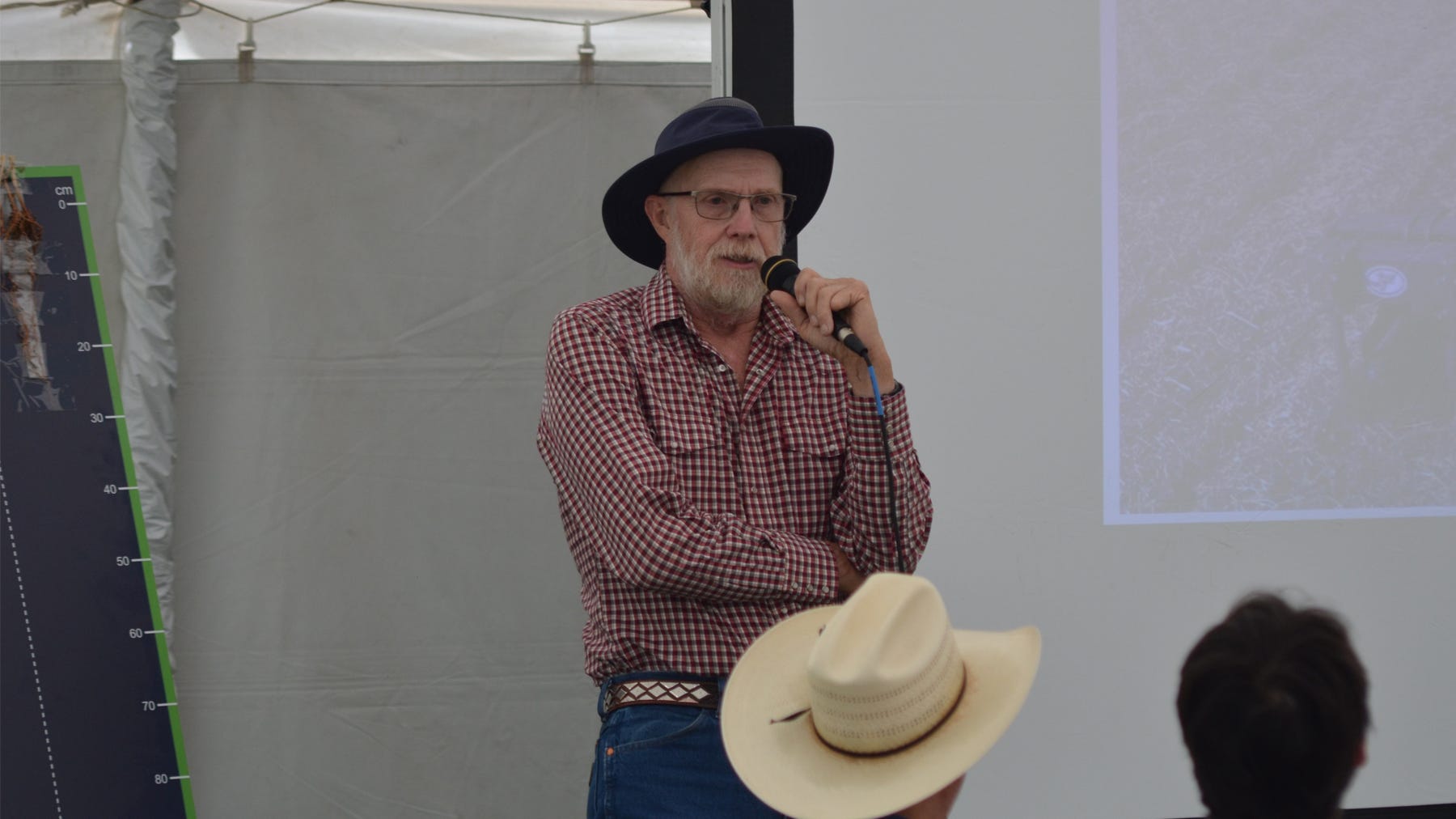
At a Glance
- Two producers and one agronomist offered pro tips on cover crops.
- Integration planning is different, depending on each operation.
- Improving soil health through the use of cover crops takes time and management.
Everyone has their own idea and approach, especially to cover crops. Along with cover crops, “sustainability” is a buzzword thrown around plenty in agriculture. But what does it mean?
Specific aspects of that word and its meaning were on display at the 19th annual University of Nebraska West Central Research, Extension and Education Center’s water and crops field day near North Platte, Neb., this past summer.
Featured speakers looked at potential sustainable practices, especially implementing cover crops with a practical, tested approach.
Here are a few of the important pro tips and comments from two producers and one agronomist on cover crops, and how they might be implemented into an operation:
Don Batie, farmer, Lexington, Neb. “We strip-till everything,” says Don Batie, a farmer from Lexington, Neb. “We terminate the cover crop after planting. The cover crops help retain residue on the field and provide root action to repair the soil for the next year. We want growing plants between a dead cover crop.”
Over the past two years, Batie has been a part of UNL On-Farm Research trials in Dawson County, using wheat and turnips for cover crops. “We also tested rye” for these trials, he adds.
While the rye offered up to three times more biomass as a cover crop than wheat, Batie will not use rye on his farm because he raises wheat, and the rye seeds are too difficult to separate. He doesn’t want to get rye in his wheat stand.

TESTING IT OUT: Don Batie, a farmer from Lexington, Neb., talked about testing different cover crop strategies through the UNL On-Farm Research program studies.
As part of the second year of another four-year research project on his farm, Batie interseeded a seven-way mix of cover crops on June 13 by dropping off a row unit from his planter where the corn plants were growing.
“A week after planting, we had nice rows coming in,” he says. “A month later, we had quite a bit of growth considering the corn canopy. By Aug. 7, the buckwheat in the mixture was dead, but the cowpeas were taking off like crazy.”
By late August, the grasses in the mixture were going down, and there was no yield difference in the first year of the trial.
Batie grows cover crops after wheat harvest, planting what he calls a cash crop of sorghum, sudan and millet, treated soybean seed, canola and turnips. This forage crop will be cut and baled after the first hard frost, and there will be growth within that stubble that will overwinter.
“With the price of forages right now, that cover crop we plant after wheat cashes out better than corn does,” Batie adds.
Jimmy Emmons, farmer, Leedey, Okla. It may have taken a “double-dog dare” for Oklahoma farmer Jimmy Emmons to try different crops and different cover crops in his rotation, but many of those experiments have paid big dividends in what Emmons calls “wow” moments.
Growing up in a farming operation that was clean tillage, Emmons has been a believer in no-till since 1995. “It worked well, but I was still a ‘take-all’ guy,” he says. “As a cattleman, I had to hay it or graze it, and that’s the reason no-till started failing for me.”
He started planting cover crops in the middle of a drought in 2011.
“I thought that I couldn’t plant cover crops because they took too much water,” he explains. “If something was growing, it was using water.”

MAKING A BELIEVER: Jimmy Emmons of Leedey, Okla., discussed his “ah-ha” moment with cover crops, when he understood that cover crops and dry conditions can co-exist.
But Emmons tried an experiment after his wheat crop was harvested, planting cover crops across a field, but leaving a big square area of the field bare. Setting out moisture and temperature probes and working with local conservation agencies, Emmons was surprised at the results.
After planting winter wheat in the fall, the next spring he could visibly see the square area that had no cover crops was much worse than the area where cover crops were planted.
“That’s not what we expected,” Emmons says. “We probed into the square, and at 16 inches depth, the probe stopped. We thought it was a hard pan, but it was actually a dry layer where there was no more water in the profile below.”
Taking soil samples from both cover-cropped and bare areas back to the lab, researchers found that the bare area had significantly less moisture in the soil than the cover-cropped area.
“Every year since then, it’s been the same results,” Emmons says. Testing the soil temperature in the top 4 inches of the profile on a day when it was 113 degrees F, they found that the temperature in the cover cropped ground was 81 degrees F. The temperature in the bare soil was 130 degrees F.
Emmons says that soil microbes are just like humans. When it is 75-80 degrees F, they can get some work done, but when the temperature rises up to 100 degrees, they slow down and shut down.
“These results were a game-changer for me,” he says, “because it was not what I was taught.”
For Emmons, cover crops are just one aspect of a whole toolbox of practices — including heavy stock density grazing, minimizing soil disturbance and trying to mimic Mother Nature — as ways to improve water infiltration rates and ultimately repair and improve overall soil health on his land.
Alex Rose, agronomist, Bayer Water Utilization Learning Center, Gothenburg, Neb. Weed suppression may be one of the top reasons producers use cover crops, says Alex Rose, agronomist with the Bayer Water Utilization Learning Center at Gothenburg, Neb.
“When we talk about cover crops, the first thing we need to think about is why we want to do it,” says Rose, “because it’s a big challenge, especially in some areas.”
Weed suppression has been the No. 1 reason he believes farmers are interested in cover crops. With tough resistant weeds such as Palmer amaranth, cover crops provide another tool to manage these weeds, Rose says.
“It won’t fix it overnight,” he adds, “but cover crops are a great tool to have in your pocket to derail weed emergence, improve soil fertility and soil health. It takes time, so you need to be patient. These things will pay over time.”

TAKES TIME: Alex Rose (left), agronomist with the Bayer Water Utilization Learning Center in Gothenburg, Neb., notes that fixing soil health with cover crops takes time and patience over the long haul.
Rose listed high nitrate levels in groundwater — those areas where groundwater nitrates are above 10 parts per million — as a reason for planting cover crops to capture some of those nitrates. Looking at different termination times of a cereal rye crop, even three weeks before corn planting, and nitrate levels can be diminished by up to 70%, he says.
Preventing soil erosion is another reason. “We can clearly see that cover crops do a good job of holding that soil together,” Rose says. “Of course, I would combine cover crops with no-till.”
Rose notes that soybeans are more forgiving than corn when talking about cover crop termination dates. “Soybeans are better than corn to play with because they can better tolerate different termination times,” he explains. “Terminating cover crops one week before planting soybeans on irrigated ground can provide greatly increased weed suppression. That’s what our data is saying.”
On either no-till or strip-till ground, there are benefits to cover crops, especially under irrigation. But it may take time to see results in soil health and soil characteristics, so it takes patience, Rose adds.
About the Author(s)
You May Also Like






